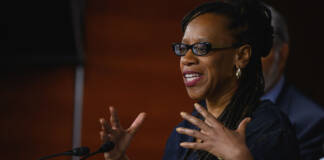by DeBray Carpenter, aka Fly Benzo
 The myth of Black inferiority has and continues to plague the Americas, resulting in the suppression and denial of the African influence in the Americas prior to Columbus’ trip in 1492. There is overwhelmingly convincing evidence that not only names Africa as the birthplace of modern human beings but also as the birthplace of civilization and of technology far ahead of its time. Though civilizations such as the Olmecs have numerous similarities which seem to connect them to Africa, many scholars, primarily Latino scholars, have unsuccessfully attempted to discredit the theory that Africans came to the Americas before Columbus, which helps explain the striking similarities between Egyptian culture and Mesoamerican culture.
The myth of Black inferiority has and continues to plague the Americas, resulting in the suppression and denial of the African influence in the Americas prior to Columbus’ trip in 1492. There is overwhelmingly convincing evidence that not only names Africa as the birthplace of modern human beings but also as the birthplace of civilization and of technology far ahead of its time. Though civilizations such as the Olmecs have numerous similarities which seem to connect them to Africa, many scholars, primarily Latino scholars, have unsuccessfully attempted to discredit the theory that Africans came to the Americas before Columbus, which helps explain the striking similarities between Egyptian culture and Mesoamerican culture.
According to Michel N. Laham, M.D., and Richard J. Karam, J.D., in their informative essay, “Did the Pheonicians Discover America?” evidence shows that there were actually two trips made to the Americas long before Colombia. The first of the two trips was taken circa 600 B.C. by the Egyptian Pharoah Necho with the aid of the seafaring Phoenicians. The second trip took place circa 450 B.C. by the Carthaginians. These voyages have for some reason been excluded for the traditional history books.
This, however, comes as no surprise considering the fact that much of the overwhelmingly convincing evidence that ties Native American civilization to Africa is suppressed. Genetic trees were recently produced which prove that the entire human population descends from an African female that the media named “Eve,” and geneticists subsequently found the same for the male they named “Adam.” Since the introduction of the “Adam and Eve” genetic trees, they have also been used to determine, in the first exodus, the routes the early Africans took out of Africa.
The Costa Chica region, near the Gulf of Mexico, is the area in Mexico with the highest population of Mexicans with African roots. This is primarily due to the fact that Veracruz, a city in the area, served as a slave port throughout the early colonial period.

The Gulf of Mexico, the end-point of the currents that flow from Africa to the Americas, was the coastline upon which Olmec civilization, considered to be the “mother-culture” of America, thrived. Van Sertima reports that in 1964, the International Congress of Americanists argued, “There cannot now be any doubt but that there were visitors from the Old World to the New before 1492.”
To support this claim, in 1858 an enormous stone head was discovered and described as having “Africoid” features. Upon further examination, this head was discovered to have seven braids, signifying African headdress.

Discrimination in Latin America is also widespread and prevalent. John Logan, in his educational research paper, “How Race Counts for Hispanic Americans,” places Hispanic people in three categories: Hispanic Hispanics, Black Hispanics and White Hispanics. He reports that Black Africans are significantly more subject to discrimination, especially in major Latin American cities. He also stated that they live in more densely populated neighborhoods with similar conditions to non-Hispanic Blacks.

Black inferiority is a notion so prevalent in America that mulattoes – people of mixed Black and white descent – are looked down upon and in Dr. David Pilgrim’s Ferris State University article, “The Tragic Mulatto Myth,” there are many examples of mulattoes, specifically females, portrayed in the media as unhappy and anxious to have a white lover, which would ultimately lead to their downfall. There are also other instances where a mulatto woman who could pass for white would have her secret exposed and commit suicide, other women were painted as seductresses and mulatto men were portrayed by the media as rapists who had both the “greed and ambition” of the white man combined with the “savagery and barbarism” of the Black man. Once again, the myth is Black inferiority is enforced and the Black condition exacerbated by the media.

Chicago advertising legend Tom Burrell, in his book, “Brainwashed: Challenging the Myth of Black Inferiority,” argues that the subliminal promotion of White superiority and Black inferiority has been the biggest and most successful marketing campaign in history. Burrell, leading into the first chapter of the book, quotes W.E.B. Du Bois’ statement:
“But in propaganda against the Negro since emancipation in this land, we face one of the most stupendous efforts the world ever saw to discredit human beings, an effort involving universities, history, science, social life and religion.”
With Black inferiority being so widespread and prevalent in the Americas, it comes as no surprise that people would want to disconnect themselves from their African lineage and would rather their history be considered “home-grown” or indigenous. Burrell is quoted in the Dawn Turner Trice’s Chicago Tribune article, “Challenging the Myth of Black Inferiority,” stating, “We have to understand that images, symbols and words can be so powerful and ubiquitous that they affect behavior without us knowing it.” This just goes to show the subconscious effect of propaganda on our society and the way people are perceived and prejudged.

Wilma A. Dunaway, in her scholarly book, “The African-American Family in Slavery and Emancipation,” argues that there has been a preposterous notion that slavery was a “paternal institution” that “civilized and Christianized” Africans and that they were somehow better off than many free Northern workers due in part to the fact that they were “cared for” by their masters in their non-working hours and old age.
However, much of the research surrounding the institution of slavery in the United States has been conducted by the examination of journals and diaries kept by slave owners and therefore is extremely biased to make the slave owners seem humane and the slaves to seem inferior in order to justify the ridiculous institution of slavery and to downplay the impact that it had and continues to have on people of African descent as well as the shaping of Western society.

Bayview Hunters Point community advocate and straight-A City College student DeBray “Fly Benzo” Carpenter can be reached on Facebook, at Fly Benzo’s Blog, where this story first appeared, or via flybenzo@gmail.com.
http://youtu.be/tu2EoSA3TXY





